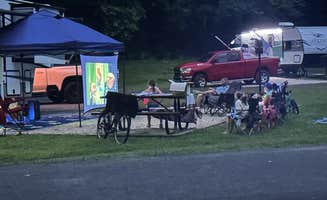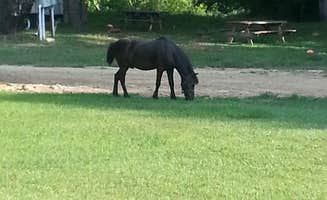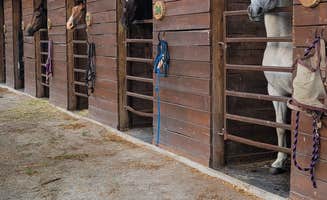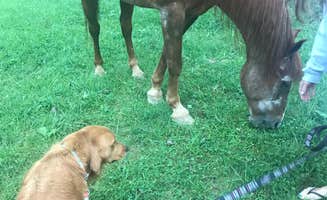Horse campers visiting southeastern Ohio find numerous trails winding through forested terrain between 600-1000 feet elevation. The region contains significant remnants of iron furnace operations dating to the 1800s, creating unique historical features along trails. Winter camping requires additional preparation as temperatures frequently drop below freezing from December through February with occasional snowfall impacting trail conditions.
What to do
Explore Lake Hope trails: Lake Hope State Park Campground connects to extensive hiking networks where "You are plopped down smack dab in the Zaleski State Forest...so pick a trail, any trail." The paths feature "tall canopies, fern ground cover, a wild assortment of fungi and wildlife at every turn," with terrain that is "undulating but very doable."
Paddle the waters: Rent watercraft on calm inland waters rather than just riding trails. Lake Hope offers "a nice flatwater paddle. Get there early and watch the water lilies open," and visitors can "enjoy camping in many ways rather if it's by tent (the way I prefer) or by camper" with access to "canoe/kayak rental."
Visit historical structures: The region contains significant iron production history. "As history buffs will know that Ohio was one of the nation's leading iron producers back in the day." The "haunted Moonville Tunnel is nearby and worth the short drive and hike" though "it is becoming defaced by disrespectful taggers."
Rock formations exploration: Hocking Hills State Park Campground provides access to dramatic geological features where "Out-of-staters are unaware of the incredible beauty that Hocking Hills brings to Ohio." Be sure to "visit Conkles Hollow and Old Man's Cave for stunning rock formations and waterfalls. And for an incredibly exciting cave, take a trip to Rock House."
What campers like
Trail variety: At Zaleski State Forest, equestrians appreciate that "The trails are well marked and easy to follow. And there are several loop sections so you can easily plan various tips accordingly." This creates flexibility for riders of different skill levels exploring the forest on horseback.
Night sky viewing: Clear nights in the rural area provide excellent stargazing opportunities. "Amazing at night for stargazing!" The distance from major cities reduces light pollution, creating optimal viewing conditions for astronomical observation after trail riding.
Wildlife encounters: The forests harbor diverse animal species. "We ended up meeting our guide kitty friend at camp 1- most likely dumped which sucks but very friendly." Riders regularly spot "deer, snakes, a wild turkey even wandered into our camp in May 2018."
Reliable water sources: Unlike some primitive horse camps, "There are three backpacking camps (3 in total) there is water and a toilet," though campers note the "water is definitely well water tastes meh better off bringing a filter just in case." These water points allow equestrians to refill supplies without carrying excessive amounts.
What you should know
Site selection matters: At Strouds Run State Park Campground, "Sites are only rented in person once you arrive, they have clear instructions at the entrance. Sites were nice and level, but a bit on the smaller side." Understanding this system helps ensure getting appropriate space for horses and equipment.
Limited connectivity: Cell service varies significantly across the region. "NO SERVICE PLAN ACCORDING make sure you have a map especially to get out of the park!!!!" Download offline maps before arrival or bring paper maps, particularly important when navigating horse trails.
Weather impacts: Environmental factors affect both camping comfort and trail conditions. During summer months "the FOG on the lake at night!!!!¡ It gets so bad you can't see past the end of your boat!!¡!!¡" Morning fog can obscure trail markers and create hazards for early riders.
Seasonal variations: Facility operations change with the calendar. "We were there in early November for the leaves and it wasn't too crowded then." Spring brings muddy trails while "the bathrooms are sub par but all you would really need anyway."
Tips for camping with families
Select appropriate trails: When bringing children to horse camps, choose routes matching their experience level. At Iron Ridge - Lake Vesuvius, "The Whiskey Run Trail, which was short and hilly, but conveniently located right off the campground" offers a manageable option, while "The very short (but rewarding) Rockhouse Trail is right on top of the major lake action."
Combine activities: Incorporate non-riding opportunities to keep children engaged. "We also did some kayaking as well as driving to different hiking paths around the area. We did a 'walking tour' that had TERRIBLE directions but we had a blast anyway."
Pack for primitive conditions: Most horse campsites have minimal facilities. "In the walk-in family campground, not the main campground. The sites are mostly far apart from one another and the area is fairly dense woods leaving you feeling a peaceful solitude." Remember "Most of the outhouses don't lock" so younger children may need supervision.
Consider educational programs: Some parks offer organized activities. "The naturalists feed hummingbirds at the nature center. They pull the feeders for awhile leading up to a 'Feed the Hummingbirds' program. So cool! The birds come right to you!"
Tips from RVers
Site leveling challenges: At Greenbo Lake State Resort Park, "Camp sites are very small and very unlevel, had to raise back of camper and put front about a 1/4" off ground to get close to level. Site around is sloped in all directions." Bring additional leveling blocks when bringing horse trailers with living quarters.
Power configuration awareness: Some campgrounds have unusual electrical arrangements. "Started out bad. Had showed up at site with no electricity available. Was told had to share box but only one 30 and one 50 amp. So if you both have a 30 amp the other has to get an adapter for the 50."
Plan for weather considerations: Regional weather patterns impact RV camping. "Flood waters after heavy rains" can affect accessibility, particularly for larger rigs pulling horse trailers. Consider higher elevation sites during rainy seasons.
Water pressure variations: Infrastructure quality varies between campgrounds. "Beautiful place to camp. Some sites are more difficult for parking a camper than others... the water pressure was extremely high" which can damage RV plumbing systems without appropriate regulators.





